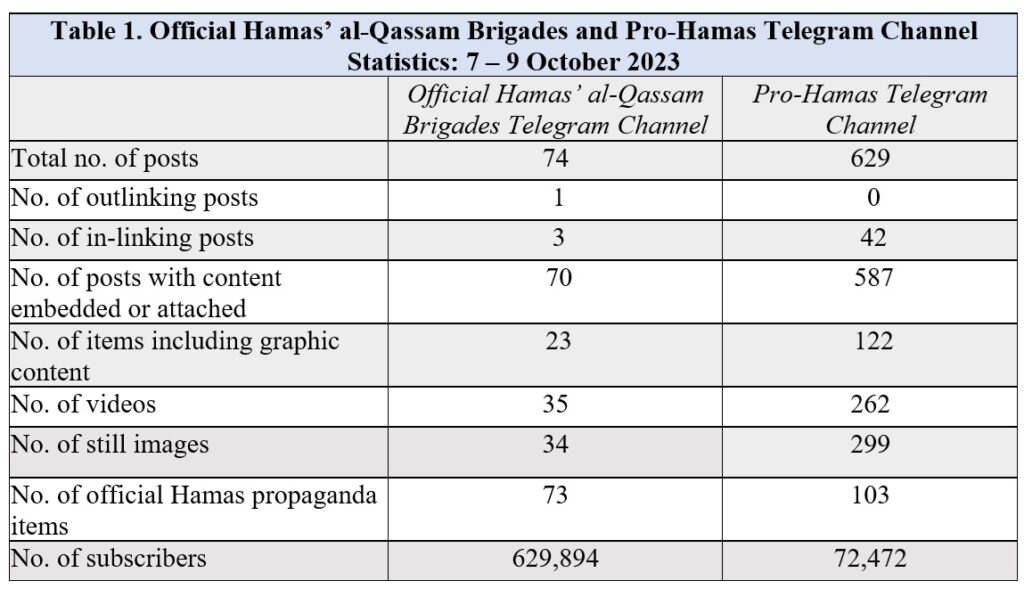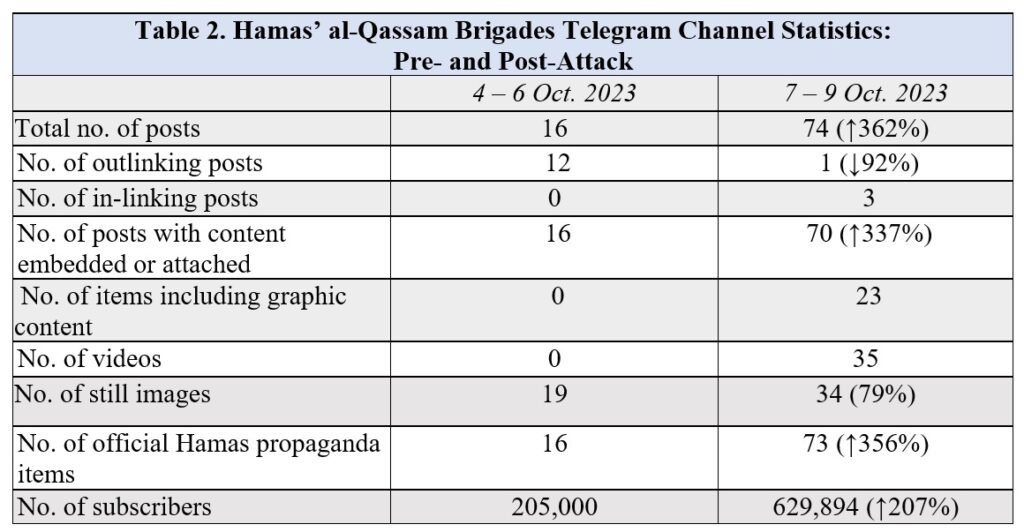By Sean McCafferty & Kamil Yilmaz
On the morning of Saturday, 7 October 2023, a barrage of rockets targeted Israel from Gaza, followed by militants from a variety of Gaza-based terrorist organisations breaking through checkpoints and military positions around Gaza and entering Israel. This led to unprecedented violence against nearby Israeli military positions, kibbutzim, and the Supernova music festival.
The attack, titled “al-Aqsa Flood” by the perpetrators, was carried out by a variety of groups but appears to have been led and coordinated by the military wing of terrorist organisation Hamas, known as the Izz ad-Din al-Qassam Brigades. At time of publication the attacks launched by Hamas and the subsequent Israeli assaults on Gaza have resulted in the deaths of an estimated 1,400 Israelis—with a further c.240 taken hostage—and over 10,000 Palestinians.
Hamas has a sophisticated approach to propaganda, largely focused on its constituents in Gaza. The group also has longstanding official presences on platforms such as Telegram, with supporters less clearly affiliated with Hamas spreading its propaganda on mainstream social media.
In addition to their social media presence, Hamas also operated a suite of websites. These websites were disrupted by distributed denial-of-service attacks (DDoS) within hours of the attack on 7 October. Attribution of the DDoS attacks remains unclear, but in the absence of Hamas’ websites other online spaces, such as the al-Qassam Brigades Telegram channel, quickly came to prominence in disseminating content related to the ongoing violence.
Telegram was a key platform for the dissemination of attack-related images, videos, and other propaganda, which went viral in the hours and days following the initial attacks. This two-part Blog post thus analyses the dissemination of propaganda by official and pro-Hamas channels on Telegram between 7-9 October as the attacks and their immediate aftermath unfolded.
The present post focuses on the increases in activity levels and concomitant increase in subscriber numbers in the three days post-attack. Part Two will focus on the nature of the content shared in the same period.
Data Overview
This analysis is based on data gathered between 7 October and 9 October 2023 from two Telegram channels sharing propaganda related to the unfolding violence in Israel and Palestine: an official channel of the al-Qassam Brigades and an unofficial pro-Hamas Telegram channel.
A total of 719 posts were collected over the data collection period, 703 between 7-9 October, and a further 16 when retrospectively analysing activity in the channels between 4-6 October (i.e., in the lead up to the attacks).
To be included posts must have contained content items in addition to text (i.e., posts containing only text without other content were excluded from collection). These posts represent all types of content shared in the channels including images, videos, audio, links, and written statements.
Items were coded as graphic if they included graphic violence and gore. Items branded with official logos or banners of designated terrorist organisations were coded as official propaganda content.
The official al-Qassam Brigades channel (see Table 1) featured 74 posts that included propaganda content. Of these posts, just one was an outlink (i.e., to another platform), to the al-Qassam Brigades website. The vast majority—73 out of 74 items—of content shared in the channel was branded with an official logo or banner with the sole exception a video likely produced by an Israeli bystander of the aftermath of Hamas rocket strikes. The channel featured 23 items of graphic content, all claimed to be footage of Israeli military dead.

Per Table 1, the pro-Hamas channel featured far more content than its official counterpart, with 629 posts between 7-9 October, including those containing images, videos, audio, in-links, and written statements. It also shared a larger quantity of Hamas-branded content (i.e., 103 items) than the official Hamas channel studied. Within the channel were 122 items of graphic content featuring Israeli military and civilian dead as well as Palestinian civilian dead.
The pro-Hamas channel featured 42 in-linking posts (i.e, links within a platform; for example, a hyperlink posted within Telegram to a different Telegram channel), all of which were links to the channel itself. This use of in-linking likely facilitated the sharing of content among supporter networks, with items of propaganda easily forwardable accompanied with a link to the pro-Hamas Telegram channel. This may have contributed to the massive increase in the channels’ subscribers in the aftermath of the attacks and the virality of the content shared within the channel.
Comparative Analysis: Activity
Both the pro-Hamas and official al-Qassam Brigades channels showed a significant change in the quantity of content shared between 4-9 October. The pro-Hamas channel was completely inactive prior to the attacks, not having posted any content since 5 July 2023. On 7 October, it erupted with activity. As can be seen in Table 1, the al-Qassam Brigades Telegram channel also displayed a low level of activity in the three days leading to 7 October.
The type of activity apparent in the official channel in this period is also distinctive from the aftermath of the attacks (see Table 2). There were just 16 posts made in the three days pre-attacks, all featuring images and 12 accompanied by outlinks to the al-Qassam Brigades website. A dramatic increase in the quantity of propaganda is apparent post-attacks, as is a dramatic decrease in outlinks to the group’s website, likely due to the disruption of Hamas websites following the eruption of violence on 7 October.

Both Telegram channels saw their number of subscribers dramatically increase across the three-day period and in the week following data collection. The pro-Hamas channel’s subscriber numbers grew from 40,000 to over 72,000 (reaching a peak of over 100,000 in October) while the official al-Qassam Brigades channel grew from 205,000 subscribers to just over 629,000 in the data collection period (and had reached a peak of over 694,000). Both channels saw a reduction in subscribers from their peak with 645,361 subscribers to the official al-Qassam Brigades and 80,712 subscribers to the pro-Hamas channel at time of publication
Due to the headline grabbing nature of the violence, it is unlikely that the huge subscriber increases represents thousands of supporters of the terrorist organisation. The mass media attention tied to such seminal violence, likely led journalists, analysts, academics, and the curious to these channels. The desire for direct and up-to-date insights into the violence and to keep in step with new content boosted the reach of Hamas propaganda.
Content shared within these channels has been spread very widely across mainstream online spaces too. At time of publication, the al-Qassam Brigades appear to continue to have relative freedom to disseminate their propaganda through their official media channels and websites, despite disruption to their main website, and restriction of access to their Telegram channels for Android users.
Conclusion
Comparative analysis of this portion of the data thus shows how both an official Hamas and a Hamas supporter Telegram channel had limited activity in the build up to the attacks, which ramped-up significantly in the aftermath of the attacks. And that this was accompanied by huge increases in channel subscriber numbers also: a 207% increase for the al-Qassam Brigades channel and a slightly less dramatic 80% for the supporter channel.
Part Two of this Blog post will address the similarities and differences in the types of content shared on the same official and supporter channels in the wake of the Hamas attacks of 7 October.
This work was supported by the Tech Against Terrorism Europe project, funded by the EU’s Internal Security Fund (Project 101080101).
Sean McCafferty is a research assistant at Dublin City University. Sean is a graduate from the Erasmus Mundus International Master’s in Security, Intelligence and Strategic Studies at Glasgow University, Dublin City University and Charles University. His research focuses on open-source intelligence, terrorism, propaganda, and technology. Twitter: @SeanRMcCafferty
Dr. Yilmaz currently works as a post-doctoral researcher at the Cyber Threats Research Centre (CyTREC), Swansea University in the UK. He is interested in Computational Social Science and his research interests include political violence, anthropology of terrorism, radicalization and deradicalization processes related to terrorism, terrorists’ use of social media and malign influence operations.
Image credit: PEXELS
Want to submit a blog post? Click here.
